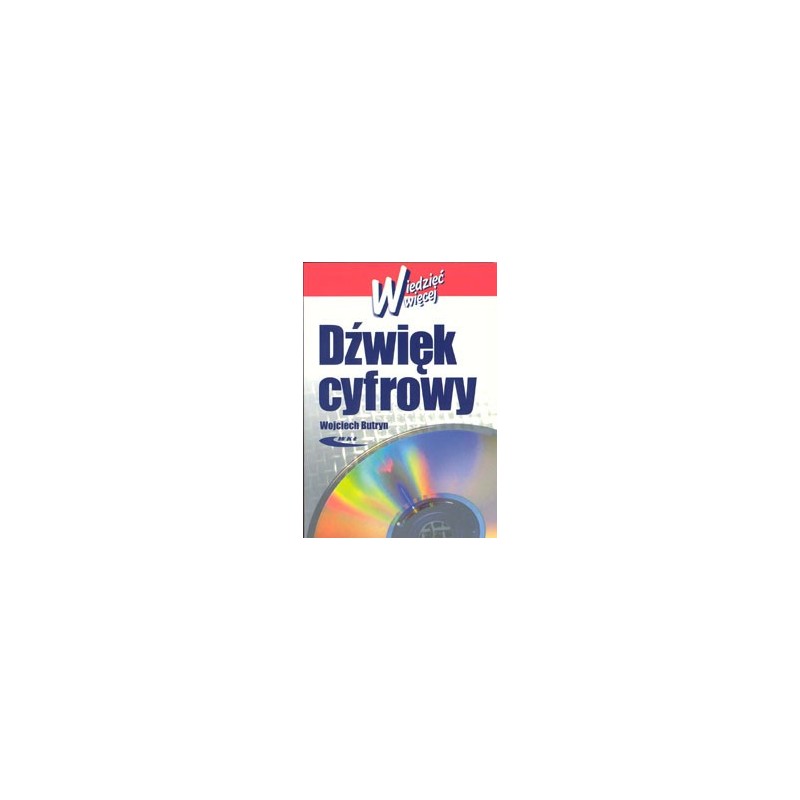


zł44.00 tax excl.
Wojciech Butryn
| Author: Wojciech Butryn ISBN: 83-206-1433-3 Format: B5, 232 pages Publisher: WKiŁ |
| About the book (only in Polish) |
| The book describes the basic issues related to sound and the techniques of its processing, ranging from studio engineering of audio systems, through multi-channel processing systems, to the possibilities of computer processing. There are descriptions of market surround systems, ways of encoding audio signals and techniques of sound transmission (also via the Internet), omitting a detailed description of storage technology and media used in sound technology. The possibilities of using signal processors for processing of audio signals are also presented. Recipients: amateurs of digital multichannel sound, audio hobby, HiFi, DVD, video and home theater, directors and sound engineers, and everyone interested in this subject. Table of Contents: 1. From mono to surround - the theory of evolution according to audiophile 1.1 Mono 1.1.1 Mechanical systems and electrical systems 1.1.2 The first speakers and the development of radio broadcasting 1.1.3 Demand 1.2 Stereo 1.2.1 The origins of the uprising, genesis 1.2.2 A sound image 1.2.3 Stereo systems 1.2.4 Audio path list during the recording process 1.3 Quadraphony 1.3.1. Further increase and number of dimensions 1.3.2 The first quadro systems 1.4 Surround 1.4.1. Specifics of surround systems 2. Audio signal processing path 2.1 What we call the audio path 2.2. Signals in analogue and digital form 2.3 Elements of the audio track - analog 2.3.1 Input transducers 2.3.2 Analog mixing console 2.3.3. Power amplifier 2.3.3.1. Switching buttons 2.3.3.2 Tone controllers 2.3.3.3 Mute and panorama 2.3.3.4 Volume control 2.3.4 Output transducers 2.4 Elements of the audio track - digital 2.4.1 Anti-aliasing filter 2.4.2 Sample-remembering system 2.4.3 Analog-to-digital converter 2.4.4 Digital-to-analog converter 2.4.5 Output filter 2.5. Possibilities of connecting analog and digital paths 3. Surround - types of systems 3.1 Dolby Surround 3.2 Dolby Surround Pro Logic 3.3 Dolby Surround Pro Logic II 3.4 Dolby Digital 3.5 Dolby Digital EX 3.6 DTS 4. Requirements for surround systems 4.1 THX 4.2. DCS 4.2.1. Virtual 3D Mode 4.2.2 Cinema Studio Mode 4.3 SONY 4D 5. Audio coding and compression systems 5.1 PASC 5.2 MUSICAM 5.3 ATRAC 5.4 AC-3 5.5 Dolby E 5.6 CAC 5.7 MPEG 5.8 MP3 5.9 AAC 5.10 MLP 6. Multi-channel recording systems 6.1 Mixing tables 6.1.1 Analogue table 6.1.2 Digital table - Spirit Digital 328 Soundcraft 6.2 Multi-track tape recorders 6.2.1 Analogue 24-track tape recorder. 6.2.2. DA98HR Tascam digital tape recorder - 8-track 6.2.3 Fostex D2424 - hard disk recorder 6.2.4. Digital recorder MX-2424 Tascam 6.3 Multi-channel cooperation cards with a computer 6.3.1 Creative Sound Blaster Live 6.3.2 Motu 6.3.3 Aark 20/20 6.3.4 Digidesign Pro Tools 6.4 Types of digital audio signal transmission 6.4.1 S / PDIF 6.4.2 AES / EBU 6.4.3 I2S • e 6.4.4 ADAT 6.4.5 TDIF 6.4.6 FireWire (IEEE 1394, Sony and? Link) 6.4.7 mLAN 6.5. Synchronization and time codes 6.5.1 Synchronization 6.5.2 Jitter 6.5.3 Types of time codes 6.5.4 Synchronizers 7. Possibilities of computer signal processing 7.1. Inputting a signal to the computer. 7.1.1 Music cards 7.1.2. USB (Universal Serial Bus) 7.1.3 CD-ROMs 7.1.4. Network 7.2. Computer audio recording formats. 7.2.1 Conversion of audio file formats. 7.3 Signal processing 7.3.1 Purpose and possibilities 7.3.2. Input / output programs 7.3.3. Specialized stereo editing programs 7.3.4. Multi-channel mix programs 7.3.5 Sequeners 7.3.6. Support programs (Plug-In) 7.4. Outputting a signal from a computer 7.4.1 From the music card to the speakers 7.4.2 On the carrier (permanent) 8. Music on the Internet 8.1. Computer network technologies useful in transferring music 8.2. Music on the internet 8.3 Internet-related websites 8.4 Multimedia 8.5. Copyright and the Internet 9. Implementation of audio signal processing algorithms on DSP 9.1 Requirements and fields of application of DSP processors 9.2 DSP characteristics 9.3 Basic DSP functional blocks 9.4. Construction of the EVM system 9.5. Description of programming methods 9.6. Construction of a typical assembly language program for Motorola DSP 10. Possibilities of modeling room acoustics using DSP 10.1 Modeling of room acoustics 10.1.1. Spatial layout 10.1.2 Description of theoretical methods of testing closed systems 10.1.3. Description of pulse method for testing acoustics 10.1.4 Characteristics and reverberation time and room acoustic factors 10.1.5 Programming modeling 10.1.6. Description of the simulation program modeling the acoustic field occurring in the Boston Concert Hall 11. DSP adaptation of Dolby Pro Logic decoder algorithm 11.1 Initial decoder information, the first version of the program 11.2 Description of the operating principle of the Dolby Pro Logic decoder 11.2.1. Highlighting technique 11.2.2. Domination of reinforcement 11.2.3. Channel compensation technique 11.2.4 Directional domination of the signal 11.2.5 Determination of domination 11.3 Pro Logic adaptive matrix 11.4 Adaptation of the Dolby Pro Logic decoder algorithm for DSP. 11.4.1 Basic blocks included in the program 11.4.2 Program in syntax of assembler 12. DSP applications, development possibilities, summary Bibliography Appendix A The program code is pasthru.asm Appendix B The decoder.asm program code |
No product available!
Jacek Andrzej Michalski
Tomasz Jabłoński
No product available!
No product available!
Marek Piotrowski
Jacek Bogusz
Krystyna Maria Noga, Marcin Radwański
Steven W. Smith
Krzysztof Krykowski
Robert Brzoza-Woch

Wojciech Butryn
